| +++ Selected works by Gabriel Fauré +++ |
 |
Dear musicians
This November marks the 100th anniversary of Gabriel Fauré's death.
When Bärenreiter launched the first two volumes of the "Gabriel Fauré Œuvres complètes" in 2010, the start of a Fauré Complete Edition was not as self-evident as it may seem to us today. Even though Fauré was undoubtedly regarded as a central composer in Paris at the beginning of the 20th century and, as professor of the composition class at the Conservatoire in Paris, had a great influence on the generation of Ravel and Enesco, only part of his compositional work had established itself in the repertoire: in addition to his "Mélodies", it was mainly chamber music works, the "Pavane" and, of course, the "Requiem". Many works for piano, orchestra and choir were overshadowed by sometimes unfortunate circumstances.
Around half of his oeuvre is now available in critical editions within the OCGF, many of which are first critical editions that have led to first recordings.
Let yourself be enchanted by Fauré's distinctive musical language, the magic of his musical colours as well as the expressive power of his melodies and be inspired to discover his multifaceted oeuvre.
Further information on these editions and music samples can be found on our website. All editions can be ordered directly from our webstore.
We look forward to receiving your orders.

Your international sales and marketing team
|
|
|
| Fauré, Gabriel | | Barcarolles for Piano | Editor: Grabowski, Christophe
| | BA 10842 | EUR 25.95 | 9790006542499 | Fauré’s 13 “Barcarolles”, composed over a period of almost four decades (1882–1921) are highly representative of his output for piano and are regarded as his most characteristic works.
They reflect his breaking free from the Romantic idiom, particularly that of Chopin and Mendelssohn, developing an independent musical language in which he combined tradition and the emerging modernism. |
|
 | Scholarly-critical edition based on the Urtext from “Œuvres complètes de Gabriel Fauré”
Musical text at the forefront of scholarship including comprehensive source research
With performance suggestions (Fr/Eng/Ger) |
|
| Fauré, Gabriel | | 5 Impromptus for Piano | BÄRENREITER URTEXT
Editor: Bartoli, Jean-Pierre | | BA 11851 | EUR 18.50 | 9790006574476 | | Fauré composed his 5 impromptus in two distinct periods of his career, in 1881–83 and 1906–09. Inspired by Chopin’s example, the brilliant early impromptus (opp. 25, 31 and 34) resemble lyrical études that seem like improvisations but are laid out in symmetrical form with a coda. In contrast, the impromptus opp. 91 and 102 are far more boldly conceived in their sonority, harmony and virtuosity. This scholarly-critical Urtext edition is edited by Jean-Pierre Bartoli, a musicologist and professor at the Sorbonne. It presents the musical text from the corresponding complete edition volume (BA 9471) which was published in 2020 as part of the “OEuvres complètes de Gabriel Fauré”. The edition contains a knowledgeable Foreword (Fr/Eng/Ger) and Critical Commentary (Eng). It goes without saying that a reader friendly engraving, practical page turns and valuable performance suggestions are also included. |
|
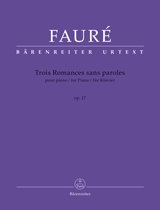 | Includes detailed notes on interpretation by Jean-Pierre Bartoli (Fr/Eng/Ger)
First Urtext edition to include the first version for piano two-hands of No. 3
Medium level of difficulty, well-suited for piano lessons |
|
| Fauré, Gabriel | | Trois Romances sans paroles for Piano op. 17 N 52 | BÄRENREITER URTEXT
Editor: Bartoli, Jean-Pierre | | BA 11852 | EUR 12.50 | 9790006575718 | With this early cycle (1863/64), Fauré follows in the footsteps of Mendelssohn's “Lieder ohne Worte” (Songs without Words) whilst at the same time enrolling into the French tradition of the “Romance sans paroles” as penned by composers such as Thalberg, Kalkbrenner, Gounod or Bizet before him. It was not until 1880 that the pieces, the first of his piano works, appeared in print during the same year as the Ballade op. 19. The numerous reprints, transcriptions and arrangements during Fauré’s lifetime testify to the great popularity of these works, which are also well-suited for piano lessons.
This Urtext edition takes all available sources into account, including the recording by Fauré himself and an early four-hand version of No. 3. It is based on the musical text of the “Œuvres complètes” of Gabriel Fauré and also contains the first version for piano two-hands of the third “Romance sans paroles” in the appendix. |
|
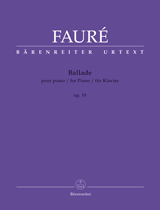 | Published on the basis of “Œuvres complètes de Gabriel Fauré”
Incorporates the latest research and findings regarding the sources
Scholarly-critical Urtext edition with advice on performance practice |
|
| Fauré, Gabriel | | Ballade for Piano op. 19 N 56a | BÄRENREITER URTEXT
Editor: Grabowski, Christophe | | BA 10841 | EUR 16.50 | 9790006542253 | Fauré’s piano works are of central importance within his compositional oeuvre. He dedicated his “Ballade”, composed in 1879, to his teacher Camille Saint-Saëns. Structurally and in terms of its lyrical character the work breaks from the genre’s epic form and takes on the traits of the sonata form. In 1881 Fauré arranged his “Ballade” for piano and orchestra and the work was premiered in this new scoring.
Drawing on the most recent discoveries and comprehensive source research, the work is presented in a scholarly-critical Urtext edition. The publication, which is based on the “Œuvres complètes de Gabriel Fauré”, includes a detailed foreword and notes on performance practice. |
|
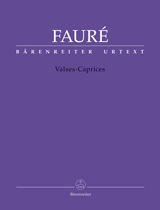 | Based on the “Œuvres complètes de Gabriel Fauré”
Based on the latest research findings and extensive source studies
Informative forewords with advice on performance practice (Fr/Eng/Ger) |
|
| Fauré, Gabriel | | Valses-Caprices | BÄRENREITER URTEXT
Editor: Grabowski, Christophe | | BA 10843 | EUR 22.50 | 9790006542505 | Fauré’s four “Valses-Caprices” (1882/83–1894) demonstrate various forms of his treatment of the waltz in combination with the free form of the caprice.
The composer drew his inspiration for his “Valses-Caprices” in the first place from works such as Liszt’s “Valse-Impromptu” and his “Valse à capriccio” and the famous “Valse-Caprice” by Anton Rubinstein.
These important groups of works are now made available in scholarly-critical Urtext editions based on the “Œuvres complètes de Gabriel Fauré” and reflect the latest state of research. Detailed forewords offer information on the genesis and significance of the compositions as well as valuable suggestions on historical interpretation.
All the available manuscript and printed sources as well as piano rolls containing recordings by the composer have been taken into consideration, leading to new discoveries particularly regarding the “Valses-Caprices”. |
|
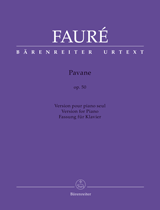 | Urtext edition based on the “Gabriel Fauré Œuvres complètes”
Musical text at the cutting edge of scholarship incorporating all the sources, including Fauré’s recordings
Informative introduction, notes on performance (Fr/Eng/Ger) and Critical Commentary (Eng) |
|
| Fauré, Gabriel | | Pavane for Piano op. 50 | BÄRENREITER URTEXT
Editor: Bartoli, Jean-Pierre | | BA 11832 | EUR 8.50 | 9790006575381 | Fauré’s “Pavane” was composed for orchestra in 1887, followed by a version for chorus and orchestra in that same year. Three decades later Serge Diaghilev had it choreographed for his Ballets russes – a sign of its great popularity. “Pavane” exudes the spirit of Paris’s fêtes galantes at the turn of the century. A version for solo piano appeared in 1889; it was most likely prepared by Fauré himself, who performed it several times and even recorded it for player piano.
Our Urtext edition is based on the musical text from “Gabriel Fauré Œuvres complètes”. The editor has drawn in particular on the original solo piano print while also consulting the autograph of the orchestral version and Fauré’s second recording of the piano version. Elegant engraving and practical page-turns invite players to study this popular piece. |
|
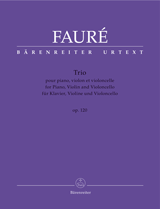 | First scholarly-critical edition of this work
High-quality Urtext edition based on “Œuvres complètes de Gabriel Fauré”
Foreword (Eng/Fr/Ger) |
|
| Fauré, Gabriel | | Trio for Piano, Violin and Violoncello op. 120 N 194 | BÄRENREITER URTEXT
Editor: Sobaskie, James William | | BA 7902 | EUR 24.95 | Score with parts | 9790006539581 | Gabriel Fauré’s Piano Trio, his penultimate work, was composed in 1922-23 and published in June 1923. The three-movement work clearly shows Fauré’s ability to combine a transparent texture with charming and elegant themes.
Until now the composition has always presented musicians with considerable problems as the score offers conflicting readings when compared with the separate string parts. Without reliable information on the different readings, important basic information for an appropriate interpretation of the work has been lacking.
Bärenreiter’s first ever critical edition of this masterpiece finally unites the parts with the score. All variants appear in the critical commentary to the corresponding complete edition volume of “Œuvres complètes de Gabriel Fauré”. |
|
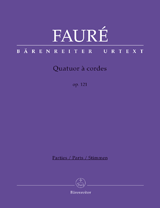 | First scholarly-critical edition of this work
High-quality Urtext edition based on “Œuvres complètes de Gabriel Fauré”
Standard repertoire work for every string quartet
Foreword (Eng/Fr/Ger) |
|
| Fauré, Gabriel | | Quatuor à cordes / String Quartet op. 121 N 195 | BÄRENREITER URTEXT
Editor: Sobaskie, James William | | BA 7901 | EUR 43.95 | Parts in slipcover | 9790006539574 | Gabriel Fauré’s only string quartet which was composed in 1923-24 is the composer’s final work and was written at the suggestion of his publisher Jacques Durand. Until then, Fauré had always put off writing a string quartet, evidently because of Beethoven’s imposing shadow.
When Fauré composed the quartet he was already extremely ill. He added dynamics and slurs only in some parts of the exposition of the first movement and then asked his former pupil Jean Roger- Ducasse to complete the work. Roger- Ducasse’s additions were however very extensive; he even altered and supplemented some of Fauré’s own markings in the exposition.
Bärenreiter’s first ever scholarly critical edition of the quartet utilises all sources including the composer’s letters which provide valuable insights into the origins of the composition.
In particular, Fauré’s penultimate work, the Piano Trio op. 120, was used to guide the editor with his emendations. |
|
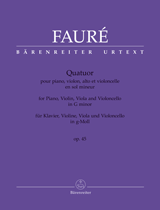 | First scholarly-critical editions of these important chamber music standards
High-quality Urtext editions based on the “Œuvres complètes de Gabriel Fauré”
Preface (Eng/Fr/Ger)
Clearly laid out scores and parts with optimum page turns |
|
| Fauré, Gabriel | | Quartet for Piano, Violin, Viola and Violoncello in G minor op. 45 N 92 | BÄRENREITER URTEXT
Editor: Herlin, Denis | | BA 7904 | EUR 52.00 | Score with parts | 9790006539604 | The Piano Quartet op. 15 was an extremely successful work during the composer’s lifetime and was reissued numerous times; it was one of Fauré’s compositions that helped to advance his reputation as a composer of great chamber music.
The Piano Quartet op. 45, although not as popular in Fauré’s lifetime, has also become a standard in chamber music concerts today. This Urtext edition is based on the first edition engraved by Röder, but it also relies on Fauré’s autograph for the exact placement of dynamics and articulation.
Bärenreiter’s first ever scholarly-critical editions of Gabriel Fauré’s much loved chamber music are based on the “Complete Works of Gabriel Fauré”. All available sources have been critically examined. |
|
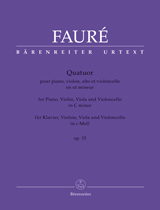 | First scholarly-critical editions of these important chamber music standards
High-quality Urtext editions based on the “Œuvres complètes de Gabriel Fauré”
Preface (Eng/Fr/Ger)
Clearly laid out scores and parts with optimum page turns |
|
| Fauré, Gabriel | | Quartet for Piano, Violin, Viola and Violoncello in C minor op. 15 N 48 | BÄRENREITER URTEXT
Editor: Herlin, Denis | | BA 7903 | EUR 46.50 | Score with parts | 9790006539598 | The Piano Quartet op. 15 was an extremely successful work during the composer’s lifetime and was reissued numerous times; it was one of Fauré’s compositions that helped to advance his reputation as a composer of great chamber music.
The Piano Quartet op. 45, although not as popular in Fauré’s lifetime, has also become a standard in chamber music concerts today. This Urtext edition is based on the first edition engraved by Röder, but it also relies on Fauré’s autograph for the exact placement of dynamics and articulation.
Bärenreiter’s first ever scholarly-critical editions of Gabriel Fauré’s much loved chamber music are based on the “Complete Works of Gabriel Fauré”. All available sources have been critically examined. |
|
| Fauré, Gabriel | | Pavane for 3 Flutes | | Editor: Woodfull-Harris, Douglas | | BA 7405 | EUR 10.25 | Performance score | 9790006499762 | | Being dominated by the winds, and particularly the flutes, Fauré's famous Pavane for orchestra (1886) especially lends itself to an arrangement for three flutes. ln this version the haunting melody, rather than being confined to the first flute, permeates the entire trio texture. |
|
| Fauré, Gabriel | 4 Mélodies
for Flute and Piano | | Editor: Pfündl-Frittrang, Evmary | | BA 7403 | EUR 15.50 | Score with part | 9790006498901 | Gabriel Fauré (1845-7924) was among the leading French song composers of the fin de siècle. His songs combine to perfection the qualities of the French "mélodie": its flowing cantabile, its subtle harmonisation and its lyric impulse.
This volume gives flautists and their duo partners on the piano an opportunity to form an acquaintance with Fauré's art through their own performances.
Also available:
BA 6991 | Edition for Viola and Piano
BA 6990 | Edition for Violoncello and Piano
BA 7895 | Edition for Clarinet and Piano
|
|
 | High-quality Urtext edition based on the “Œuvres complètes de Gabriel Fauré”
First systematic evaluation of all sources
Based on the large orchestral version of 1900
Vocal score suitable for all versions of the Requiem |
|
| Fauré, Gabriel | Messe de Requiem op. 48 N 97b
Version of 1900 | BÄRENREITER URTEXT
Editors: Stahl, Christina M. / Stegemann, Michael | | BA 9461 | EUR 70.00 | Score | 9790006540105 | The “ Messe de Requiem” is probably the internationally best-known and most frequently performed work by Gabriel Fauré . The composer’s first version was limited to just five movements and small-scale forces with low strings, harp and organ. The work was then expanded several times culminating in the version for large orchestra of 1900. This orchestral version forms the basis of this edition.
Despite its comparatively long period of gestation, the Requiem forms a stylistic unity. Unlike other requiem settings, the composer foregoes any theatrical gestures in this work. A restrained dynamic range together with graceful melodic writing for both soloists and choir give the work a gentle and optimistic character. | | |
|
 |
Sacred Works for Small Vocal Ensembles by Fauré
BÄRENREITER URTEXT
Editor: Schauerte-Maubouet, Helga
The motets and choral pieces, composed with the distinctive features of the Madeleine organ in mind, enchant with their colourful, floating harmonies and convey a certain intimacy even with their ritualized Latin texts. These works are very well suited for performances by small vocal ensembles. A novelty is the inclusion of the double bass part (ad libitum) which does not appear consistently in the first editions but corresponds to the musical practice at the Madeleine.
Numerous gems such as the "Cantique de Jean Racine" or the "Messe basse" are published in performing editions based on the musical text of the "Gabriel Faure – Oeuvres completes". |
BA 25136 | Cantique de Jean Racine for 4-part mixed choir (SATB) with organ or piano op. 11 N 42a | Choral score (Fr) | EUR 4.25 | minimum order quantity: 10 copies | 9790006575022
BA 25151 | Messe basse for three female voices (solo and choir), and organ or harmonium N 163 | Choral score (Fr) | EUR 4.75 | minimum order quantity: 10 copies | 9790006575176
BA 25137 | Ave Maria (N 26) | Choral score (Lat) | EUR 5.00 | minimum order quantity: 10 copies | copy on request | 9790006575039
BA 25138 | Tu es Petrus (N 28a) | Choral score (Lat) | EUR 5.00 | minimum order quantity: 10 copies | copy on request | 9790006575046
BA 25139 | Noel, op. 43 no. 1 (N 89) | Singing score (Fr) | EUR 5.00 | copy on request | 9790006575053
BA 25140 | O salutaris, op. 47 no. 1 (N 95 a) | Singing score (Lat) | EUR 5.00 | copy on request | 9790006575060
BA 25141 | Maria Mater gratiae, op. 47 no. 2 (N 96) | Singing score (Fr) | EUR 3.75 | 9790006575077
BA 25142 | Ecce fidelis servus, op. 54 (N 108 a) | Singing score (Lat) | EUR 5.00 | copy on request | 9790006575084
BA 25143 | Tantum ergo, op. 55 (N 110 a) | Choral score (Lat) | EUR 6.00 | minimum order quantity: 10 copies | copy on request | 9790006575091
BA 25144 | Ave verum, op. 65 no. 1 (N 123) | Singing score (Lat) | EUR 2.75 | 9790006575107
BA 25145 | Tantum ergo, op. 65 no. 2 (N 124) |Choral score (Lat) | EUR 2.75 | minimum order quantity: 10 copies | 9790006575114
BA 25146 | Sancta Mater (N 125) | Choral score (Lat) | EUR 5.00 |minimum order quantity: 10 copies | copy on request | 9790006575121
BA 25147 | Salve Regina, op. 67 no. 1 (N 128) | Singing score (Lat) | EUR 5.00 | copy on request | 9790006575138
BA 25148 | Ave Maria, op. 67 no. 2 (N 129) | Singing score (Lat) | EUR 3.75 | 9790006575145
BA 25149 | Tantum ergo (N 156 a) | Choral score (Lat) | EUR 2.75 | minimum order quantity: 10 copies | 9790006575152
BA 25150 | Ave Maria, op. 93 (N 162) | Singing score (Lat) | EUR 5.00 | copy on request | 9790006575169
BA 25152 | Il est ne le divin enfant (N 107a) | Choral score (Fr) | EUR 2.75 | minimum order quantity: 10 copies | 9790006575183
BA 25153 | Noel d'enfants (N 111) | Choral score (Fr) | EUR 2.75 | minimum order quantity: 10 copies | 9790006575190
|
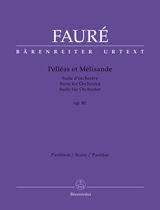 | First Urtext edition
Based on “Œuvres complètes de Gabriel Fauré”
Score and orchestral parts in a large format (25.5 x 32.5 cm) |
|
| Fauré, Gabriel | Pelléas et Mélisande op. 80 N 142b
Suite for Orchestra | BÄRENREITER URTEXT
Editor: Tait, Robin | | BA 7895 | EUR 28.50 | Full score | 9790006562565 | Incidental music with the famous "Sicilienne"
Fauré wrote “Pelléas et Mélisande” in 1898 originally as incidental music to Maurice Maeterlinck’s like-named play. After the premiere and subsequent performances, he set about reworking the musical material into an orchestral suite. The premiere of the originally three-movement suite took place in February 1901 under the baton of Camille Chevillard.
In December 1912, the four-movement version of “Pelléas et Mélisande” was finally premiered. The additional movement, the Sicilienne, was taken from the third interlude of the incidental music. This delightful piece would later become one of Fauré’s most popular compositions and now exists in countless arrangements. | | |
|
| Fauré, Gabriel | Masques et Bergamasques op. 112 N 185b
Suite for Orchestra | BÄRENREITER URTEXT
Editor: Tait, Robin | | BA 7894 | EUR 28.50 | Full score | 9790006562541 | In the style of commedia dell'arte
In 1918 Gabriel Fauré, then 73 years old, received a commission from Prince Albert I of Monaco to write stage music invoking the atmosphere of the “commedia dell’arte”.
The four-movement orchestral suite op. 112, consisting of “Ouverture”, “Menuet”, “Gavotte” and “Pastorale”, combines previously unpublished parts of this stage music. The “Pastorale” of 1919 was Fauré’s last composition for orchestra, the “Ouverture” originated in a piece of 1864 for piano duet and the original version of the “Gavotte” was written for piano as early as 1869. The op. 112 orchestral suite demonstrates how the composer, now older and more experienced, reworked and improved his earlier music. | | |
|
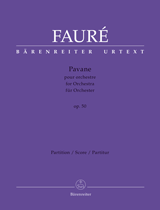 | First edition of the original version for orchestra
Urtext based on the “Œuvres complètes de Gabriel Fauré”
Large format orchestral parts (25.5 x 32.5 cm) |
|
| Fauré, Gabriel | | Pavane for Orchestra op. 50 N 100a | BÄRENREITER URTEXT
Editor: Tait, Robin | | BA 7887 | EUR 15.95 | Full score | 9790006534289 | Bärenreiter’s scholarly-critical edition of Gabriel Fauré’s evergreen, the Pavane op. 50, has been edited by Robin Tait as part of the “Complete Works of Gabriel Fauré”.
The popularity of the work is mostly attributed to its many arrangements but the original version for orchestra is being published here for the first time. Shortly after completing the orchestral work, Fauré began work on a version for choir, which was actually premiered before the orchestral version.
This Bärenreiter edition offers conductors and orchestras a reliable Urtext edition of the “Pavane’s” original orchestral version which will surely enhance symphonic concert programmes everywhere. | | |
|
| Further orchestral works are available on hire. |
 | Contains a wealth of previously unknown research findings
In French with translations of key terminology into German and English
Comprehensive indices |
|
| Nectoux, Jean-Michel | | Gabriel Fauré - Catalogue of works | Gabriel Fauré. Œuvres complètes VII/1
Catalogue of works | | BVK 2229 | EUR 274,00 | 9783761822296 | | Price reduction for a subscription | Gabriel Fauré (1845-1924) is best known as a composer of songs, the Requiem, several pieces of chamber of music and the Pavane. The Œuvres complètes de Gabriel Fauré, published by Bärenreiter since 2010, has taken on the task of displaying his music in all its variety to a new listening public. Now the eighth volume has appeared in print: Jean-Michel Nectoux’ thematic catalogue.
With 201 entries in chronological order, the catalogue lists every known work by this French composer. The entries, each with its new ‘N’ number, provide information on opus numbers (those assigned during Fauré’s lifetime), scoring, key, musical incipit, text incipit, text source, manuscript sources, date of origin, dedicatees, date of first performance, relationships to publishers, printed editions, authorial and non-authorial arrangements (if any), commentary and bibliographic references. No fewer than six indices make the volume easy to search.
The thematic catalogue (Catalogue Nectoux) will soon prove to be an indispensable reference work for anyone interested in Fauré and the music of his era. It is a distillation of Nectoux’ scholarly efforts of the past 50 years, the result of his journeys to every library where Fauré’s manuscripts are preserved – and a milestone of French musical scholarship. |
|
| The Complete Works of Gabriel Fauré |
|
|
For the first time, the Complete Works of Gabriel Fauré (1845–1924) has managed to amass all the scores which were issued during the composer’s lifetime, mostly by three different publishers. Furthermore, it offers a corrected text based on all available sources, some of which have been recently discovered. These sources include: manuscripts, corrected proofs, first editions, printed scores with corrections by the composer, etc.
The Complete Works will reveal many nearly unknown or unpublished pieces, particularly from Fauré’s youth. This will give a more complete picture of Fauré’s aesthetic development; a musician who started composing when classical impulses prevailed but quickly found his own personal harmonic language which continually developed to include the boldness of "Penelope" and the late chamber as well as piano works. Throughout the volumes abandoned works will be published such as the Allegro of the "Violin Concerto op. 14", the Symphony or "Orchestral Suite in F major op. 20". Yet, more significantly, unpublished versions of wellknown works will be uncovered and it will also be possible to discover hitherto unpublished orchestral scores or the very few songs the composer agreed to orchestrate himself.
Scientific Director : Jean-Michel Nectoux | | |
|
   
Errors excepted; price changes and delivery terms subject to change without notice.
Responsible for content (i.S. des § 10 Abs. 3 MDStV): Ivan Dorenburg.
Your contact at Barenreiter: Carolin Jetter · jetter@baerenreiter.com · Fax +49 (0)561 3105310
Bärenreiter-Verlag Karl Voetterle GmbH & Co. KG · Heinrich-Schütz-Allee 35-37 · 34131 Kassel · Germany
Managing Directors: Prof. h. c. Barbara Scheuch-Vötterle, Leonhard Scheuch, Clemens Scheuch
Firma und Registergericht: Kassel HR A 6553 · Komplementärin: Vötterle-Vermögensverwaltungs-GmbH Kassel HR B 3965
Umsatzsteuer-ID-Nr.: DE113096830
Unsubscribe
|
|
 |
|
|
|
|
|
|
|
|
|
|
|
|
|
|
|
|
|